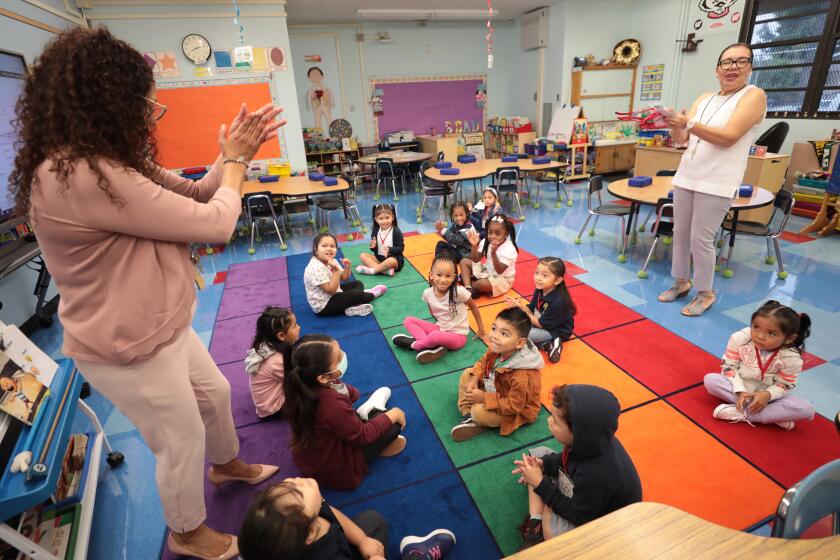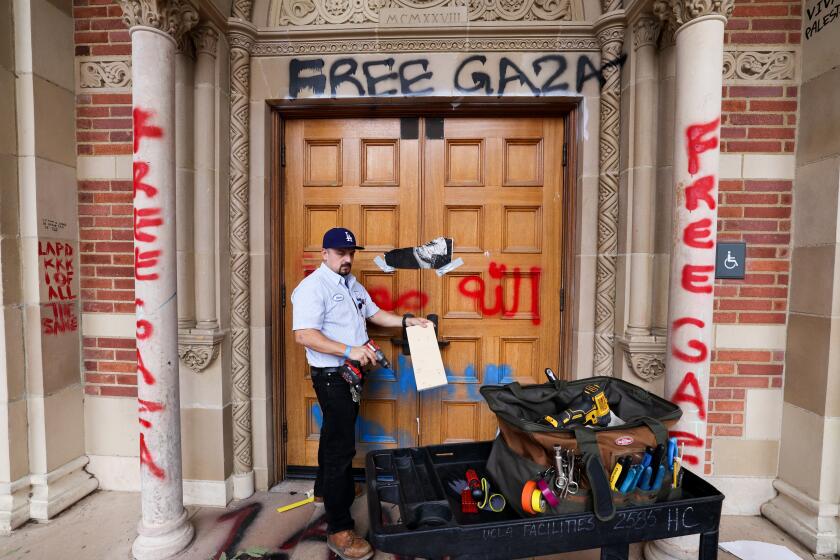New System Helps Deaf Put Signing Into English
Vivian Smith’s fifth-graders can hear neither their teacher’s voice nor the classical music in the background, yet they communicate with ease thanks to an old teaching tool with a new twist.
The children at the Mississippi School for the Deaf sign the meanings of words to each other, using flash cards that help them translate their native sign language to spoken, colloquial English.
Learning the conversational meanings of words has helped the students understand English while becoming fluent in American Sign Language, a visual language with a different word order than English.
Disheka Bland, 12, signed that she used to have difficulty with vocabulary. But her reading has improved three grade levels in two years using the flash card technique.
“It’s easy,” Disheka signed. “We chat and chitchat.”
The flash card technique, called Fairview learning, was developed by Connie Schimmel, an associate professor at Millsaps College, and Sandra Edwards, a teacher of reading and American Sign Language, or ASL.
Here’s how the flash cards work:
An English word is written on one side of the card, and the various meanings of that word are listed on the reverse. The children help one another sign the meanings of the word so they will recognize it in context when they read.
For example, a child learns to translate the word “just” into four meanings: “recently,” “exactly,” “only” and “fair.”
There are also “bridge lists” of phrases that require translation between American Sign Language and English. For example, the sign for hitting a ball “down” the street requires a sign for “into the distance,” not “down into the ground,” said Schimmel.
Many deaf children read below their grade level, Schimmel said. And most deaf children have hearing parents and teachers who use sign codes that correlate with English rather than ASL, Schimmel said.
“A deaf child, unless with a fluent ASL signer, won’t see the different signs,” she said.
The flash cards and bridge lists help the children understand words and phrases in context. At the same time, their teachers get a better understanding of ASL.
“Immediately when a child goes to read, he has to come up with the right sign, and all of sudden print becomes more meaningful to him,” said Schimmel. “What our approach does is enable people to become systematic signers from the beginning.”
First used in the classroom five years ago at the Mississippi School for the Deaf, this program helps teachers convey concepts to their students.
Cathy Broom, who teaches the ASL component of Fairview learning at the state-supported school near downtown Jackson, understands the challenges facing the children. She is deaf; her parents aren’t.
“When I was growing up, I had no communication with my family. No one could sign,” Broom signed. “Many children today are the same way.”
When she was introduced to Fairview learning, she did not know all the phrases in the bridge lists.
“I was learning a lot about English myself,” she signed. “What really struck me is that [deaf children] could read at an early age.”
David Martin, a professor of education at Gallaudet University in Washington, D.C., the world’s only four-year university for the deaf and hard of hearing, said Fairview learning is one of many new methods arising from an improved understanding of how deaf children learn to read.
Broom is most impressed with the progress shown by Victorica Monroe, 11. When Broom first tried teaching her, she had difficulty interpreting the girl’s signs. She was shy, afraid she’d make a mistake while signing.
“I tried to show her how to put things in order,” Broom signed. “Now it just flows from her. Now she’s not afraid.”
More than 60 school systems in 24 states now use this reading program, Schimmel said. Some teacher-training programs are also using the system.
The Arkansas School for the Deaf and several Arkansas public schools started using the system last year, said Marcella Della Rosa of Arkansas Educational Services for the Hearing Impaired.
She said reading grade levels have improved since the program began, but some teachers say it is too time-consuming.
Della Rosa said the program also has the reciprocal effect of helping hearing teachers sign more conversationally.
Brenda Simmons, an instructor of teacher preparation for the deaf at the University of Tennessee, was recently one of about 55 teachers to see a presentation of the program in Knoxville. She said she hopes to work Fairview learning into her school’s curriculum.
“What I like about it is that it is a systematic way for teachers to look at multiple meanings of words that give deaf children such a difficult time with reading,” Simmons said.
In Jackson, Smith’s fifth-grade class applies “bridges” to every subject.
“It’s really been fun,” Smith said. “I like the independence, the choice it gives the child.”
It also seems to have imbued confidence in the children. Reading has become exciting for these children, who used to see it as a frustration rather than a challenge.
www.millsaps.edu/www/educ/
www.gallaudet.edu
More to Read
Start your day right
Sign up for Essential California for news, features and recommendations from the L.A. Times and beyond in your inbox six days a week.
You may occasionally receive promotional content from the Los Angeles Times.






